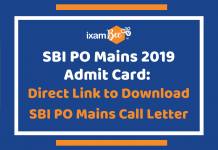Check here Data Interpretation (Mixed) Questions For Bank Exams like SEBI Grade A, SBI PO & IBPS PO
Data Interpretation for Bank Exams
Hi Readers,
With this new year has come a plethora of new opportunities that you can and must cash on. We are expecting recruitment notifications for upcoming bank exams 2024 like SBI PO and IBPS PO among others. The banking sector relies heavily on data analysis to make informed choices, especially during the recruitment process. Bank exams such as SEBI Grade A exam, SBI PO exam, and IBPS PO exam often include Data Interpretation (DI) questions to assess a candidate’s analytical and logical reasoning skills. We urge you to begin your preparation right away so that you are well prepared by the time the notification is out.
To make sure you make the most of it I have come up with a series of questions related to Data Interpretation (Mixed) Questions For Bank Exams- SEBI Grade A, SBI PO, IBPS PO which will help you in improving your speed and calculation.

In this article, we have provided 10 DI questions for Bank exams (2 sets) of DI Mixed (Pie and Bar) Chart. These are moderate level questions. Set a timer and try to solve them in 10 minutes. If it is taking more than that, figure out which question is consuming time and find a way to minimize it.
Importance of Data Interpretation in Bank Exams:
Data Interpretation questions are designed to evaluate a candidate’s ability to comprehend, analyze, and interpret numerical data presented in various forms such as tables, graphs, charts, and figures. These questions test the candidate’s proficiency in quantitative aptitude and problem-solving skills, which are essential for a banking professional.
Data Interpretation Questions For Bank Exams
We have provided a variety of Data Interpretation Questions For Bank Exams below. This will give you a fair idea of what to expect in the exam and therefore, how to go about your preparation as well.
1. Study the following pie chart and bar graph carefully and answer the questions given below:
The pie-chart shows the percentage of employees working in four different banks and the bar graph shows the percentage of employees promoted in these banks.


1. What is the total number of promoted employees in BOB and BOI together?
1) 372
2) 288
3) 526
4) 448
5) None of these
2. What is the difference between the number of promoted employees in SBI and BOI together and the number of employees in BOB and Yes Bank together who were not promoted?
1) 408
2) 294
3) 352
4) 276
5) None of these
3. What is the ratio of the number of employees promoted in BOI & SBI together to the total number of employees working in BOB?
1) 217:130
2) 253:150
3) 297:140
4) 197:120
5) None of these
4. What is the average number of employees from all the four banks together who were not promoted?
1) 248
2) 498
3) 558
4) 638
5) None of these
5. The number of promoted employees working in Yes Bank and BOB together is approximately what percent of the total number of employees working in BOI and SBI together?
1) 12%
2) 18%
3) 26%
4) 32%
5) 22%
2. The pie-chart shows the number of earphones sold by Boat and JBL during 2017-18 in six different states.
Study the graph carefully and answer the related questions.


6. Total number of Boat earphones sold in M.P is approximately what percent more or less than the total number of JBL earphones sold in Bihar?
1) 42%
2) 31%
3) 27%
4) 37%
5) None of these
7. What is the difference between earphones sold in Bihar, H.P and Gujarat together by Boat and JBL?
1) 24.6 thousands
2) 22.3 thousands
3) 28.2 thousands
4) 32.4 thousands
5) None of these
8. Total number of JBL earphones sold in U.P and Maharashtra together is what percent of Boat earphones sold in the same states together?
1) 150% 2) 110% 3)125% 4) 100% 5) None of these
9. If ratio of selling price per item of Boat earphones and JBL earphones in M.P is 5:3 and total profit earned by Boat from M.P was 66(2/3)% then find the ratio of cost price of Boat and JBL in M.P.
1) 5:3 2) 2:3 3) Cannot be determined 4) 4:3 5) None of these
10. What is the average number of JBL earphones sold in Bihar, H.P, Gujarat and U.P together?
1) 23.8 thousands
2) 18.6 thousands
3) 20.4 thousands
4) 25.2 thousands
5) None of these
Answers:
Ans:1- 4
Required total no. of promoted employees = 14% x 4000 x 25% + 35% x 22% x 4000
= 140 + 308
= 448
Ans:2- 1
Required difference = (44% x 4000 x 50% + 22% x 4000 x 35%) – (14% x 4000 x 75% + 20% x 4000 x 45%)
= 1188 – 780
= 408
Ans:3- 3
Required ratio = [(22% x 35% + 44% x 50%) x 4000]:14% x 4000
= 297:140
Ans:4-3
The average number of un-promoted employees from all the four banks
= (1/4) x (44% x 50% + 22% x 65% + 14% x 75% + 20% x 45%) x 4000
= (1/4) x [2232]
= 558
Ans:5- 5
Number of promoted employees in Yes Bank and BOB together = (20% x 55% + 14% x 25%) x 4000
= 580
Total employees in BOI and SBI together = (22% + 44%) of 4000 = 2640
Therefore, Required % = (580/2640) x 100
= 22% approx
Ans:6- 2
Required percentage = [(27% x 180,000 – 28% x 120,000)/(27% x 180,000)] x 100
= [(48600 – 33600)/48600] x 100
= (15000/48600) x 100
= 31% approx.
Ans:7- 1
Required difference = (27 + 14 + 8)% of 180 thousands – (31 + 16 + 6)% of 120 thousands
= (88.2 – 63.6) thousands = 24.6 thousands
Ans:8-1
Total no. of JBL earphones sold in U.P and Maharashtra together = 19% x 180 thousands
= 34.2 thousands
And that of Boat earphones in U.P and Maharashtra together = 19% x 120 thousands
= 22.8 thousands
Therefore, Required % = (34.2/22.8) x 100 = 150%
Ans:9-3
Let selling price per item of Boat and JBL in M.P is 5x and 3x respectively. Since, here we know only profit of Boat earphones and we have no information about profit of JBL earphones.
So, answer can’t be found.
Ans10:- 4
Required average = (1/4) x (27 + 14 + 8 + 7)% x 180 thousands
= 25.2 thousands
You can Also attempt Free Full-length Mock Tests for Various examinations like Banking, SSC, Defence and more.
Tips for Solving Data Interpretation Questions:
a) Understand the given data: Take time to carefully read and understand the information provided in the question. Identify the variables, units of measurement, and any trends/patterns in the data.
b) Practice mental calculations: Developing strong mental calculation skills will save time during the examination. Practice basic mathematical operations like addition, subtraction, multiplication, and division without using calculators.
c) Break down complex data: If the data given in the question is complex, break it down into smaller parts to simplify the analysis. Pay attention to the units mentioned and ensure that all calculations are accurate.
d) Prioritize the questions: Not all questions in a DI set carry the same weightage. Start with the questions that seem easier and less time-consuming. Allocate time wisely to maximize your chances of answering as many questions as possible.
e) Review and revise: In DI questions, precision is key. Double-check your calculations and ensure that all essential aspects of the question have been addressed before submitting your answer.
Preparation Strategies for Data Interpretation Questions:
a) Understand the exam pattern: Familiarize yourself with the SEBI Grade A exam pattern and syllabus, and weightage given to DI questions in the respective bank exams. This will help you allocate your preparation time accordingly.
b) Practice previous year question papers: Solve a significant number of previous year’s question papers to get acquainted with the types of DI questions asked in these bank exams. Focus on your weak areas and improve your speed and accuracy.
c) Take mock tests: Regularly take mock tests to simulate the actual exam environment and assess your progress. Analyze your performance to identify areas that require improvement and work on them.
d) Refer to study materials: Invest in good quality study materials and online courses that provide comprehensive coverage of DI topics. Books, online resources, and video tutorials can help you understand different approaches and strategies for solving DI questions.
Conclusion:
Data Interpretation questions are an integral part of bank exams such as SEBI Grade A, SBI PO, and IBPS PO. To excel in these exams, candidates must develop strong analytical and logical reasoning skills. By understanding the exam pattern, practicing various types of DI questions, and utilizing effective preparation strategies, candidates can enhance their performance and increase their chances of success. Remember, practice and perseverance are key to achieving high scores in DI questions.
Also read
RBI Grade B Phase 1: How to Score Well in Quantitative Aptitude?
English Questions(New Patten) for RBI Assistant, SBI Clerk
Reasoning Questions (Puzzles) for Bank Exams
English Important Questions for RBI Assistant, NABARD Grade A and SBI Clerk 2020
займ под квартирузайм по номеру телефоназайм без предоплат и комиссий















